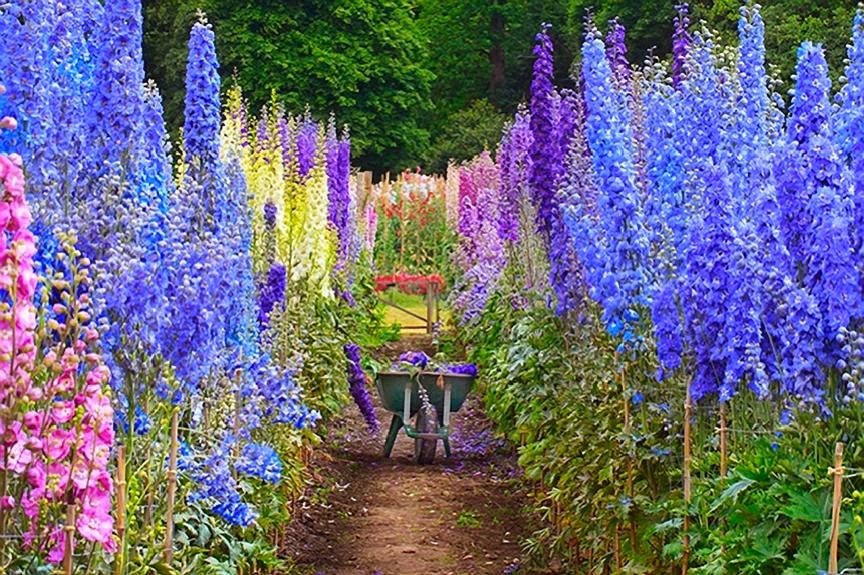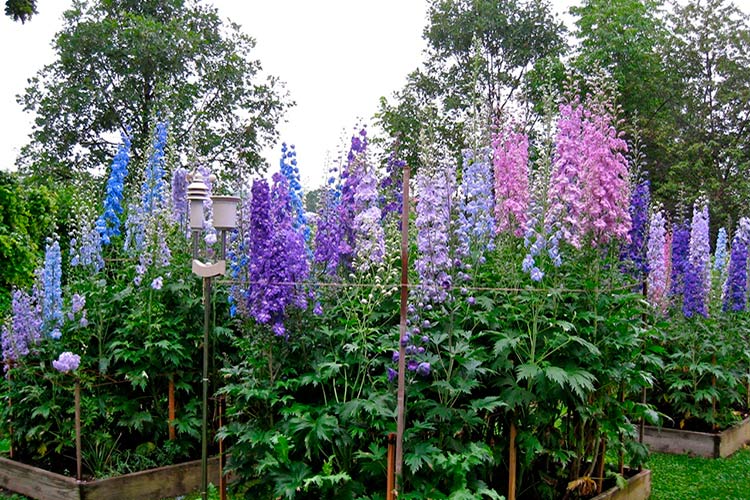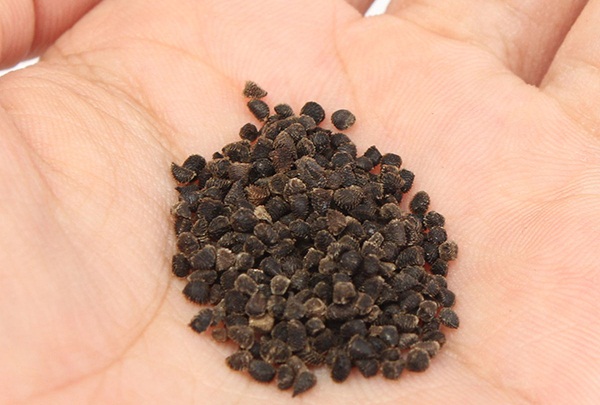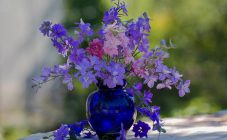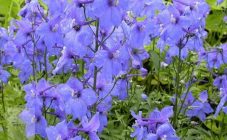Content:
Delphinium (lat. Delphinium) is a herbaceous perennial plant of the buttercup family. It reaches a height of over 2 meters. People call flowers larkspur or larkspur. Delphinium is easy to grow and care for, so it is often planted in summer cottages, next to fountains or gazebos.
Features of the delphinium
Plants are planted in areas closed from strong winds. Petals can burn on sunny days, so it is better to choose places with diffused light, where direct sunlight does not fall.
Most larkspur species have an expanded root system, that is, the main vertical root is absent. Each season, the plants release shoots that give life to new flowers.
In the south, the delphinium blooms in May-June, then blooms again in autumn. In the middle lane it blooms from June to late July and in autumn.
Delphinium is suitable for growing in Siberia. The plant can withstand temperatures as low as -40 ° C. The only danger is thaws. Due to the fact that the root system is located too close to the surface of the earth, it is not protected from withering away. Therefore, it is not recommended to plant the plant in areas where puddles form (for example, under a slope).
How to plant a delphinium
Each grower grows delphinium in his own way. Someone plants seeds in flower beds, others grow shoots at home in trays and only then are planted in the soil. It is recommended that you try both at the same time to determine which option is right for your area.
The pits for planting should be 4–5 cm deep. Each gardener determines the distance between flowers independently, because this factor does not affect growth and flowering.
How to feed the delphinium when landing? The soil that was taken out of the holes can be fertilized with organic matter: ash, peat and humus. The mixture is placed on the bottom of the pit, covered with a thin layer of ordinary earth. After this, the plants are planted.
Delphinium: care and cultivation
It is easy to care for a spur. During periods of drought, it is watered moderately. At the same time, the plant does not like stagnant water. You need to water at the root, trying not to catch the leaves. Delphinium does not require flower care, so summer residents can simply enjoy their beauty.
With proper and regular care, the delphinium blooms for up to 2 months. For the plant to bloom again, you should cut off the dried branches.
When to prune a delphinium:
- When the shoots have reached 20-25 cm, you need to cut off the thinnest and weakest. Large sprouts will receive enough nourishment for abundant and long flowering.
- The flowers can be cut and placed in a vase. If seeds are needed, then it is better to leave the flower stalks until late autumn.
It is worth noting that you need to store the harvested seeds in the refrigerator, since they do not tolerate high temperatures.Planting material is taken only from strong and healthy plants. As a rule, about 500 seeds can be collected from a bush with 5 peduncles.
Larkspur needs a garter, as it can break under its own weight.
How to tie a delphinium correctly is described below:
- You need to tie up shoots as soon as they reach 0.5 m in height.
- Even before disembarking, you should prepare long and strong stakes and place them next to the holes.
- Garters should be made of fabric (metal wire can damage the stem).
The optimal growth period for the burgers is 4 years. After that, the plant is replaced.
Delphinium perennial can attack diseases and pests, therefore, once a season, preventive tillage of the soil and the plant itself is performed. Pest medications are available at hardware stores.
During the budding period, the soil around the delphinium is fed once a season. It is better to fertilize with combined means. The introduction of only phosphorus, potassium or boron into the soil can negatively affect the plants. This is due to the fact that it is quite difficult to determine which specific trace element is insufficient in the soil on the site.
The plant is often exposed to such diseases:
- Root collar rot.
- Powdery mildew.
- Withering.
- Spider mite.
- Delphinium fly.
When flowering is over, the plant is pruned. This will save him from the appearance of diseases, as well as improve the aesthetic appearance of the garden.
Reproduction of delphinium
As a rule, novice gardeners get their first delphinium in the most affordable way - by planting seeds. However, seeds sown in garden trays may take a long time to germinate. Therefore, more experienced gardeners prefer to use the division method.
Planting seeds
Planting takes place in spring, the optimum temperature is 12-15 degrees Celsius. If the region is characterized by frosts, it is better to plant the seeds in special containers.
In the first year after seed reproduction, plants bloom weakly. During this period, they build up the root system. Each subsequent flowering will be more magnificent than the previous one. The feeding of the delphinium is carried out with organic fertilizers: manure and wood ash.
Young shoots require attention and care. If the soil is dry, it must be watered; when weeds appear, they must be removed immediately so that they do not have time to develop the root system.
Rhizome division
The division of the rhizome is a dangerous and traumatic type of reproduction of the burgundy. Dividing even young seedlings can lead to their death. If you intend to split the root, you need to stock up on the following tools:
- Shovel.
- A sharp knife.
- Wood ash.
You should dig out the rhizome together with the earth lump. Next, use a sharp knife to separate the sprouts. Moreover, if possible, it is better to do it by hand. Damaged parts must be treated with wood ash.
How to take care of delphiniums in the country
How to care for a delphinium after flowering
When the flowers and leaves dry up, the delphinium stems are cut to a height of 30-40 centimeters from the ground. So that they do not start to rot, the cut is treated with clay or wood ash.
Mulching of the soil will help prevent spring dampening of the trunk. It is necessary to cover the area with the delphinium with straw. This can be done at the end of summer, at the very least, at the end of autumn.
What neighbors to choose for a delphinium
How to plant and care for a delphinium in the country? The spur is planted in a common flower garden. Due to the fact that it has a high and lush flowering, the delphinium is placed in the background.
The only rule: flowers can be similar in shape and color, but not in height. The spur should receive a sufficient amount of diffused sunlight. In such conditions, it will delight the gardener with its abundant flowering with every sunrise.
It is not difficult to grow delphiniums in the country or in the front garden near the house. Plant care does not require special skills. Therefore, this beautiful flower is recommended to many novice gardeners.
